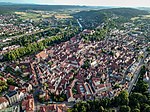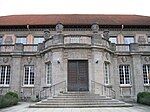Steinlach
Rivers of Baden-WürttembergRivers of GermanyTributaries of the Neckar

The Steinlach is a river with a length of 26 km (16 mi) in Baden-Württemberg, Germany. It is a tributary to the Neckar. It has its source in the Eckenbachgraben, a gap in the Swabian Alb mountain range. The source is on the territory of the town of Mössingen, on an elevation of 700 m (2,300 ft) above sea level. The Steinlach flows into a northerly direction. After taking up several streams outside of Mössingen, it flows through Ofterdingen, Nehren and Dußlingen to Tübingen, where it discharges into the Neckar.
Excerpt from the Wikipedia article Steinlach (License: CC BY-SA 3.0, Authors, Images).Steinlach
Bismarckstraße,
Geographical coordinates (GPS) Address Nearby Places Show on map
Geographical coordinates (GPS)
| Latitude | Longitude |
|---|---|
| N 48.5178 ° | E 9.0624 ° |
Address
Anlegestelle Casino
Bismarckstraße
72072 , Südstadt
Baden-Württemberg, Germany
Open on Google Maps










